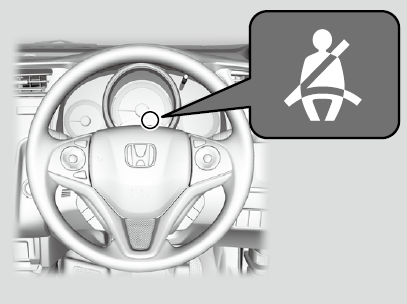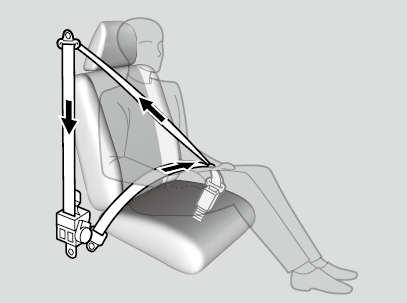About Your Seat Belts
Seat belts are the single most effective safety device because they keep you connected to the vehicle so that you can take advantage of many built-in safety features. They also help keep you from being thrown against the inside of the vehicle, against any passengers, or out of the vehicle. When worn properly, seat belts also keep your body properly positioned in a crash so that you can take full advantage of the additional protection provided by the airbags.
In addition, seat belts help protect you in almost every type of crash, including:
- - frontal impacts
- - side impacts
- - rear impacts
- - rollovers
- WARNING
- Not wearing a seat belt properly increases the chance of serious injury or death in a crash, even though your vehicle has airbags.
Be sure you and your passengers always wear seat belts and wear them properly.
- Detail
-
WARNING: Seat belts are designed to bear upon the bony structure of the body, and should be worn low across the front of the pelvis or the pelvis, chest and shoulders, as applicable; wearing the lap section of the belt across the abdominal area must be avoided.WARNING: Seat belts should be adjusted as firmly as possible, consistent with comfort, to provide the protection for which they have been designed. A slack belt will greatly reduce the protection afforded to the wearer.WARNING: Belts should not be worn with straps twisted.WARNING: Each belt assembly must only be used by one occupant; it is dangerous to put a belt around a child being carried on the occupant's lap.Seat belts cannot completely protect you in every crash. But in most cases, seat belts can reduce your risk of serious injury.Most countries require you to wear seat belts. Take time to familiarise with the legal requirements of the countries in which you will drive.The emergency locking retractor may lock if you lean forward too quickly. Slower movements will allow the belt to extend fully without locking.Models with lap seat beltYour vehicle's rear centre seat is equipped with the lap seat belt. This seat belt does not come with an emergency locking retractor.
Lap/shoulder seat belts
The front and rear outer/centre* seating positions are equipped with lap/shoulder seat belts with emergency locking retractors. In normal driving the retractor lets you move freely while keeping some tension on the belt. During a collision or sudden stop the retractor locks to restrain your body.
Proper use of seat belts
Follow these guidelines for proper use:
- All occupants should sit upright, well back in the seat, and remain in that position for the duration of the trip. Slouching and leaning reduce the effectiveness of the belt and can increase the chance of serious injury in a crash.
- Never place the shoulder part of a lap/shoulder seat belt under your arm or behind your back. This could cause very serious injuries in a crash.
- Two people should never use the same seat belt. If they do, they could be very seriously injured in a crash.
- Do not put any accessories on the seat belts. Devices intended to improve comfort or reposition the shoulder part of a seat belt can reduce the protective capability and increase the chance of serious injury in a crash.
Seat Belt Reminder
- The seat belt system includes an indicator on the instrument panel to remind the driver to fasten a seat belt.
If the ignition switch is turned to ON II*1 and a seat belt is not fastened, a beeper will sound and the indicator will blink. After a few seconds, the beeper will stop and the indicator will come on and remain illuminated until a seat belt is fastened.
The beeper will periodically sound and the indicator will blink while the vehicle is moving until the seat belt is fastened. -

*1:Models with the keyless access system have an ENGINE START/STOP button instead of an ignition switch.
Automatic Seat Belt Tensioner
The front seat is equipped with automatic seat belt tensioner to enhance safety.
The tensioners automatically tighten the front seat belts during a moderate-to-severe frontal collision, sometimes even if the collision is not severe enough to inflate the front airbags.
- Detail
-
The seat belt tensioners can only operate once.
If a tensioner is activated, the SRS indicator will come on. Have a dealer replace the tensioner and thoroughly inspect the seat belt system as it may not offer protection in a subsequent crash.
* Not available on all models
- Recommend page
